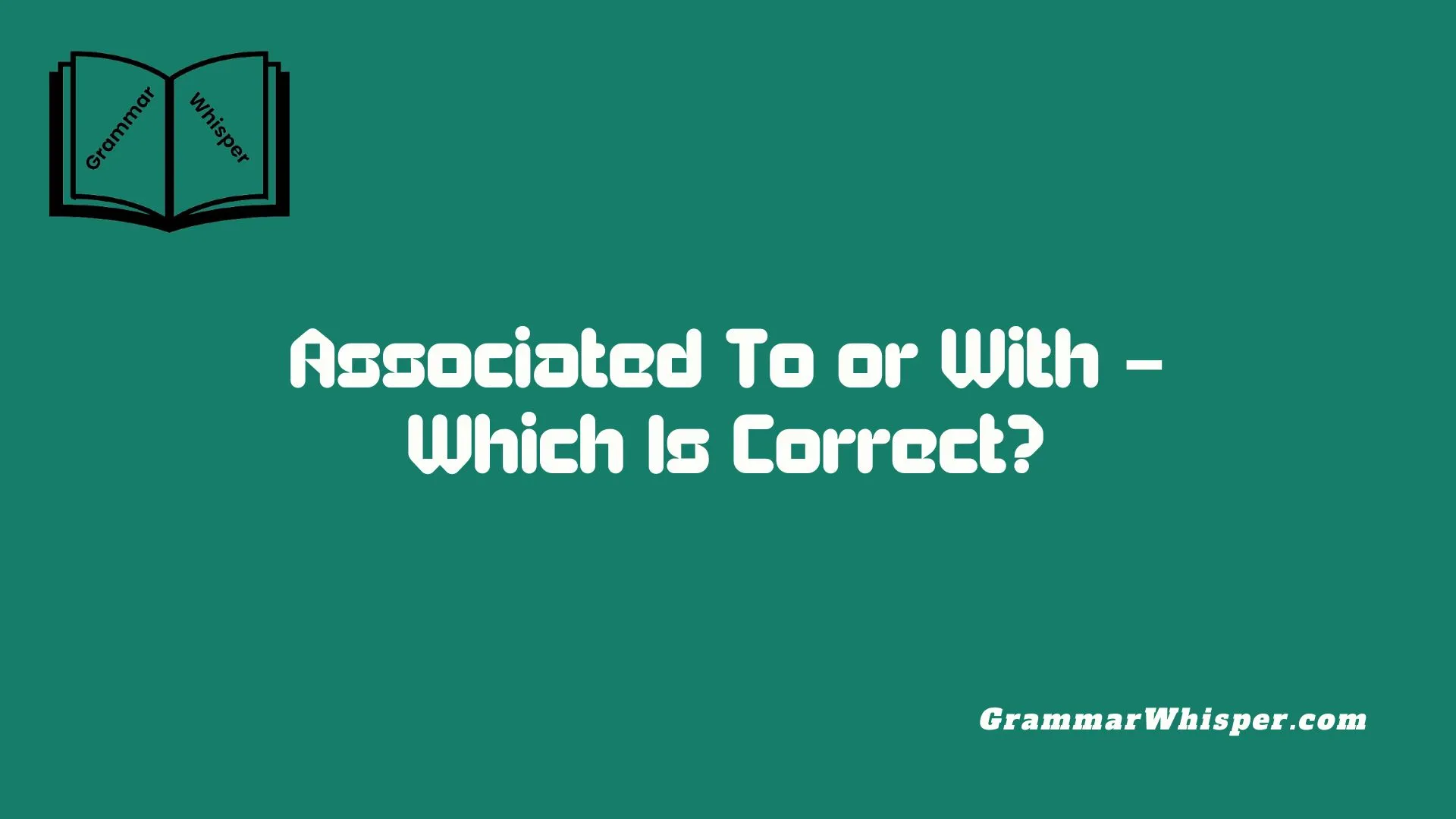Certain word combinations in English often confuse even advanced learners, especially when subtle prepositions are involved. One of the most tricky pairs misused is “Associated To or With.” I’ve seen both forms in academic and professional documents, as well as everyday speech and casual writing, which is why many struggle to spot the correct one. But a comprehensive guide on prepositional usage made the differences clear for me.
When we talk about what’s acceptable or grammatical, “associated with” is the clear winner. You’ll find it in every style manual, across all types of writing, from emails to academic papers. While “associated to” does show up in translations or informal texts, it’s not considered correct. Knowing what’s proper not only helps your message sound right, it also shows mastery in using the phrase properly. After reviewing so many student essays and corporate briefs, I can say confidently: accurate phrases don’t just reflect fluency – they deliver clarity and credibility.
The Real Confusion: Why Are “Associated To” and “Associated With” Both Used?
The mix-up between “associated to” and “associated with” often stems from language interference, especially among non-native English speakers. In languages like Spanish or French, the verb “associate” often pairs with a preposition that directly translates to “to.”
For example:
- Spanish: asociado a
- French: associé à
- Hindi: से जुड़ा हुआ (linked to)
When translated literally, these become “associated to” in English.
But here’s the catch: English doesn’t follow the same logic. While it’s easy to assume “to” works because it fits in other languages, that doesn’t make it grammatically correct in English.
What Does “Associated” Actually Mean?
Let’s break it down.
To associate means to connect or link someone or something with another thing. It can be used as both:
- A verb: People often associate chocolate with happiness.
- An adjective: The risks associated with smoking are severe.
- A noun (association): Their association with that brand hurt their reputation.
But what’s key here is the preposition that follows.
Associated With – The Grammatically Correct Option
In standard English, the correct preposition to follow “associated” is with.
Let’s look at some examples:
| Sentence | Correct? | Why |
| She is associated with the marketing team. | ✅ Yes | “With” indicates connection or affiliation. |
| These symptoms are associated with the disease. | ✅ Yes | Common medical phrasing. |
| He’s associated to the company. | ❌ No | “To” isn’t used with “associated” in proper English. |
Why “with”? Because in English grammar, the preposition “with” is used to denote association, involvement, or a relationship between two or more entities.
From authoritative sources:
- Cambridge Dictionary: “to be associated with” means to be connected with something.
- Oxford Learner’s Dictionary: Defines “associate with” as “to make a connection between people or things in your mind.”
- Merriam-Webster: Notes “associated with” as the common structure.
Why “Associated To” Is Grammatically Incorrect in Most Contexts
Despite its frequent use in informal or translated English, “associated to” is not grammatically accepted in standard English.
Why?
Because “associate” is a verb or adjective that requires the preposition “with.” When you say “associated to,” it creates a mismatch between the verb and its preposition, which disrupts the natural structure of English.
Consider this:
- ❌ This idea is associated to ancient mythology.
- ✅ This idea is associated with ancient mythology.
The first sentence sounds off because “to” typically indicates movement, direction, or transfer – not relationship or connection.
Language Transfer: How Other Languages Cause the Mix-Up
This issue is a classic example of negative language transfer – when a rule from a person’s native language incorrectly influences their English usage.
Real-life examples:
- A Spanish speaker might say: “The author is associated to the movement.” (from: “El autor está asociado al movimiento”)
- A French speaker could write: “He is associated to the decision.” (from: “Il est associé à la décision”)
In both cases, the use of “to” is a direct translation, not appropriate for English.
Grammatical Rule: How “Associate” Functions in a Sentence
Let’s break it down grammatically with simple patterns:
| Part of Speech | Structure | Example |
| Verb | associate + with | They associate chocolate with love. |
| Adjective | associated + with | Risks associated with heart disease. |
| Noun | association + with | Her association with the firm ended last year. |
Note that “to” does not appear in any of these correct grammatical structures.
Common Use Cases for “Associated With”
You’ll see “associated with” appear in various real-world contexts:
In Medicine:
- The side effects associated with the drug are mild.
- These symptoms are associated with viral infections.
In Business:
- The CEO is associated with multiple successful startups.
- Brand reputation is often associated with customer satisfaction.
In Law:
- The suspect was associated with the robbery.
- His name was associated with several lawsuits.
In Academia:
- These findings are associated with recent climate studies.
- The theory is associated with Newtonian physics.
No matter the field, “associated with” is the go-to.
Corpus Data: Which Is More Common? Let’s Look at the Numbers
To back this up, here’s data from Google Books Ngram Viewer comparing the frequency of:
- “Associated with”
- “Associated to”
📊 Google Ngram Results (1800–2019)
pgsql
CopyEdit
“Associated with” → Extremely common, stable growth.
“Associated to” → Barely visible, almost no growth.
Conclusion: “Associated with” dominates published English by a landslide. This is not just a matter of opinion – it’s supported by actual linguistic data.
Common Collocations with “Associated With”
Here’s a look at some popular word pairings used with “associated with”:
| Noun | Phrase |
| Risk | “Risk associated with surgery” |
| Brand | “Brand associated with quality” |
| Name | “Name associated with success” |
| Crime | “Individual associated with the crime” |
| Disease | “Symptoms associated with flu” |
This reinforces how natural and expected “associated with” is across different subjects.
Quick Memory Tip: How to Remember the Right Phrase
Here’s a simple trick to avoid getting it wrong:
✨ If you’re talking about a connection or link, use “associated with.” Always.
Think of “with” as a linking preposition – it connects people, ideas, and objects. “To” expresses movement (like going to a place), which doesn’t apply here.
Comparison Table: Associated With vs. Associated To
| Criteria | Associated With | Associated To |
| Grammar | ✅ Correct | ❌ Incorrect |
| Usage | Standard English | Rare, Non-native influenced |
| Example | He is associated with a nonprofit. | He is associated to a nonprofit. (✖️) |
| Tone | Professional, Academic, Formal | Informal, Jarring |
| Accepted in Style Guides? | ✅ Yes | ❌ No |
But Is “Associated To” Ever Used in English?
Rarely, yes. It might show up in:
- Legal documents outside the U.S.
- Translated texts from Romance languages
- Older British English usage (but mostly outdated)
Still, this doesn’t make it correct in modern standard usage. It’s best to avoid it unless quoting a source verbatim.
Real Examples: Right vs. Wrong
| Correct Usage | Incorrect Usage |
| She’s associated with a global nonprofit. | She’s associated to a global nonprofit. |
| The condition is associated with heart failure. | The condition is associated to heart failure. |
| His brand is associated with luxury and quality. | His brand is associated to luxury and quality. |
Expert Opinion: What Grammar Authorities Say
Let’s hear from the pros:
Grammarly: “The phrase ‘associated with’ is preferred in academic and formal writing.”
Cambridge Grammar: “Associated is most commonly followed by the preposition ‘with’ when indicating a link or connection.”
Merriam-Webster: “Associated with: to be connected with something. ‘Associated to’ is nonstandard.”
Consensus is clear: “Associated with” is grammatically correct, widely accepted, and should be your default choice.
Conclusion
So, which is correct?
✅ Associated with – Always. ❌ Associated to – Rare, usually incorrect.
Let’s wrap this up with a few key takeaways:
- “Associated with” is the only version accepted in academic, formal, and standard English.
- “Associated to” appears due to language transfer and should be avoided.
- Major dictionaries, grammar guides, and style manuals support “associated with.”
- Use “associated with” to sound natural, polished, and professional.
Mini Practice Quiz: Test Your Understanding
Fill in the blanks using either with or to:
- She is closely ________ several tech organizations.
- The risks ________ vaping are still being studied.
- He was wrongly ________ the scandal.
- This symptom is often ________ seasonal flu.
- The startup is ________ major investors.
<details> <summary>📝 Answer Key</summary>
- with
- associated with
- associated with
- associated with
- associated with
</details>
Final Tip: Use “With” Without a Doubt
When in doubt, stick with “associated with.” It’s correct, clean, and universally understood.
Want your writing to sound natural, credible, and grammatically accurate? Then “associated with” is the only way to go.
FAQs
What does “associated with” mean in English?
“Associated with” means that two or more things are connected, linked, or involved with one another. For example, “Smoking is associated with an increased risk of lung cancer.” It’s the standard form used in professional and academic English.
Is it grammatically correct to say “associated to”?
No, “associated to” is not considered correct in standard English. While it may appear in translated texts or informal usage, especially among non-native speakers, grammar authorities consistently recommend using “associated with.”
Why do people say “associated to” if it’s wrong?
The phrase “associated to” is often a direct translation from other languages like Spanish (asociado a) or French (associé à). This phenomenon is known as language transfer – where a rule from one language wrongly influences English usage.
Can I ever use “associated to” in English writing?
Technically, you might encounter “associated to” in legal or regional contexts, especially outside the U.S. However, it’s best to avoid it in academic, business, or professional writing. “Associated with” remains the preferred and correct form.
How can I remember to use “associated with” correctly?
A simple memory trick:
“With connects. To directs.”
So when expressing a connection or relationship, always choose “associated with.” Think: “Connected with a cause,” not “Directed to a cause.”











